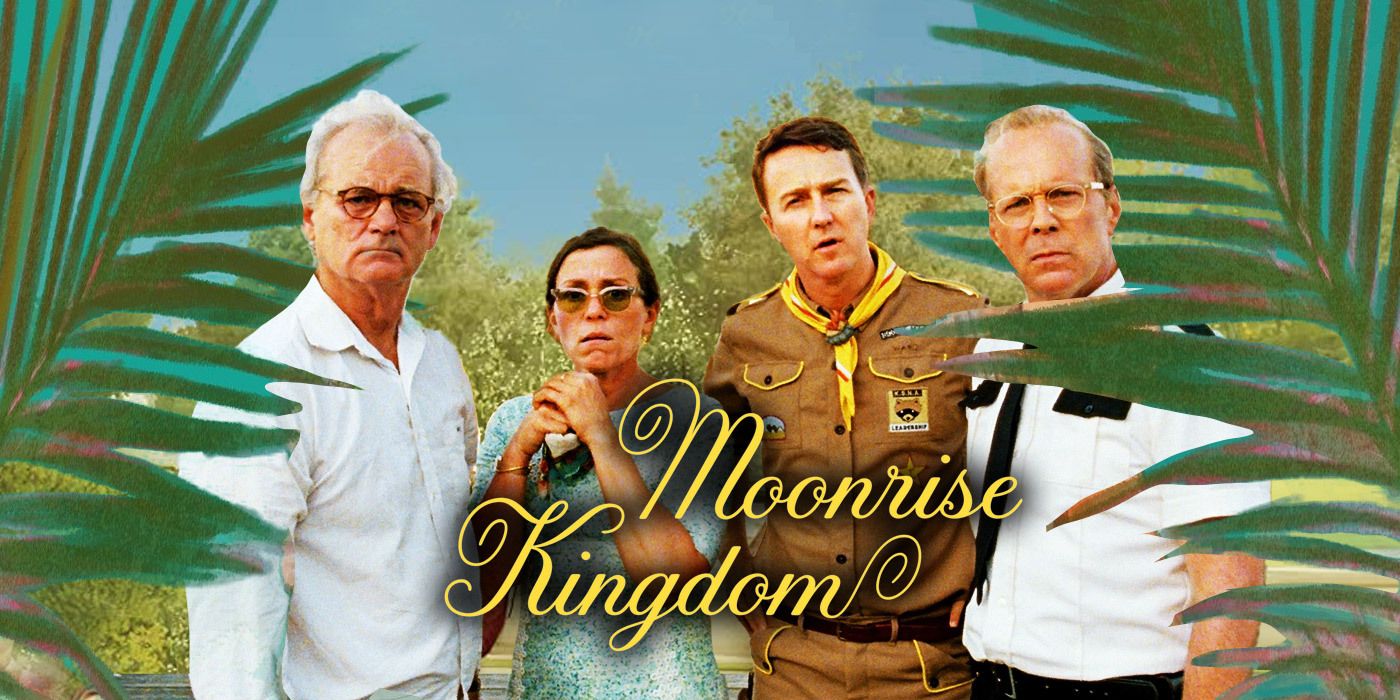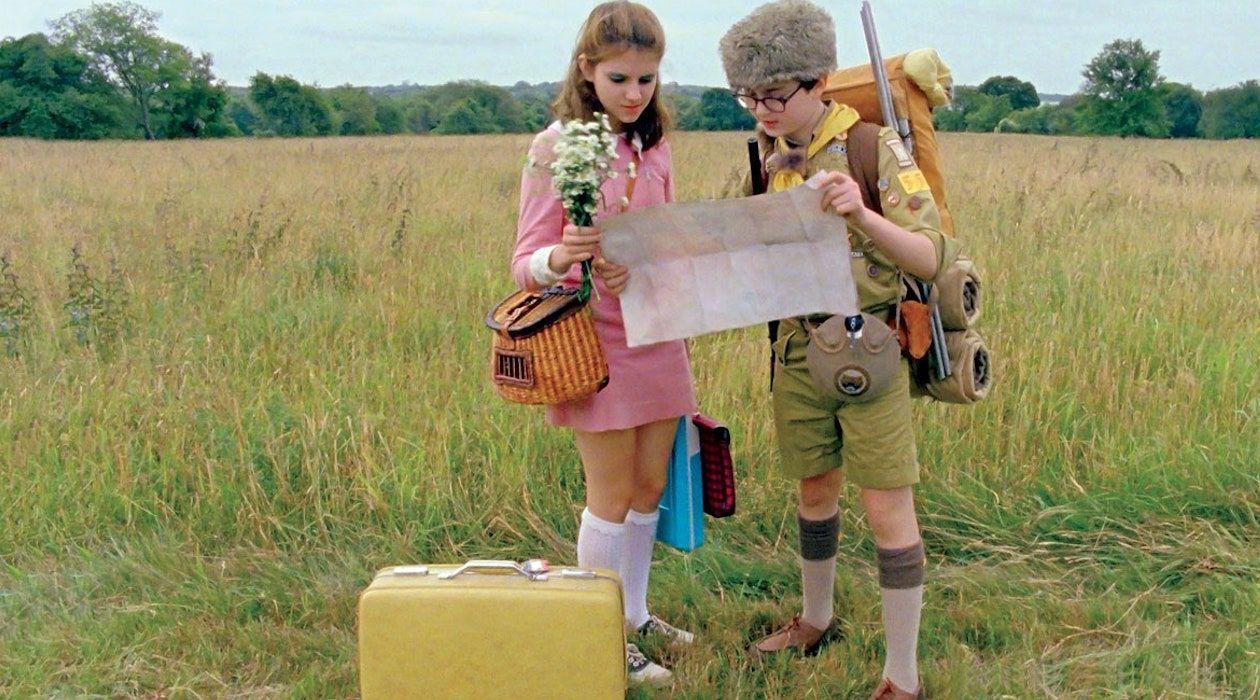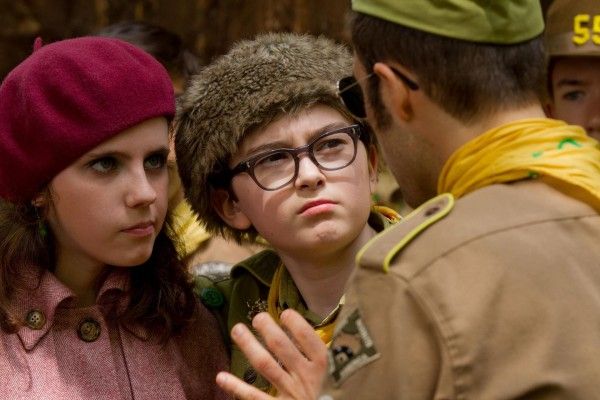Few directors are known for having such a distinctive style as Wes Anderson is. Every shot, every set piece, every costume, and every purposeful use of color, adds to his eclectic filmography and is the very foundation upon which he constructs his films. A decade after its release, Moonrise Kingdom genre-blending, offbeat preteen romance remains one of Anderson’s best works. All of Anderson’s trademarks are embedded into the film, and yet Moonrise Kingdom stands apart from his other filmography by taking inspiration from his own and co-writer Roman Coppola’s childhood fantasies. Indeed, the multitude of references to fantasy heroes, superpowers and even biblical events creates a unique sense of magical realism in the most surprising of settings.
Moonrise Kingdom takes place on the fictional New England island of New Penzance in 1965, a far cry from Anderson’s hometown of Houston, Texas. Alluding perhaps to Anderson’s own fantastical imaginings of a distant, intimate island where magical adventures take place, the director constructs the setting as being akin to a character in its own right. Bob Balaban acts as the film’s narrator by introducing the island through a series of quick cuts to a pebbled beach, a pine forest, winding creeks, hazardous cliffs, overgrown fields, a rundown dock, and an old lighthouse. Each of these locations contains important scenes later in the film, with the Narrator prophesizing that a storm of biblical proportions will hit the island. In essence, the entire film is foreshadowed through this introduction and illustrates just how purposely memorable Anderson creates his sets to be.
Moonrise Kingdom revolves around the developing relationship between two troubled preteens, Sam Shakusky (Jared Gilman) and Suzy Bishop (Kara Hayward). Having met the previous summer, the two conspire to run away and live in the wilderness to escape the loneliness they feel in their home lives. Suzy, as the eldest child of four siblings and the only daughter, remains distant from her parents while frequently getting into physical altercations at school. Sam, a junior Khaki Scout, is an unsociable orphan who is unloved and unwanted by his foster parents. The two are drawn together when Sam sneaks into the girls’ dressing room during a church play, and singles out Suzy among a flock of other girls all dressed in bird-like costumes. Suzy remains distinct from her colorful co-performers, dressed as a striking, black raven and highlighted with dark eyeliner, alluding to her unconventional personality. Sam’s first, bizarre attempt at flirting wins the shy and insecure Suzy over, and the two begin a year-long written correspondence.
Anderson’s trademark style comes into play through his introduction to Suzy by giving the audience insight into her home life Sweeping long shots take us inside the many rooms of the decadent house of the Bishops, with its stylized wallpaper, shelves overbrimming with books, and gold-framed artworks. Suzy’s parents are introduced separated by a wall, her mother (Frances McDormand) lounging in her robe while her father (Bill Murray) nonchalantly reads a newspaper. Neither seem to be interested in their daughter nor do they notice when she slips out of the house, luggage in tow, in broad daylight. In Camp Ivanhoe, where Sam is staying for the summer, Scout Master Randy Ward (Edward Norton) is introduced via his morning routine of Scout inspections, backdropped by a symphony of percussion instruments. Another one of Anderson’s hallmarks is apparent here, with his ability to draw a deadpan performance from any actor amid otherwise silly scenes. Randy discovers that Sam has run away in the middle of the night, kicking off a whole-island search that is headed by Captain Sharp (Bruce Willis). Unfortunately, Suzy’s absence isn’t noticed until much later in the evening, by which point she and Sam have already escaped into the wilderness.
It is this escape into the wilds where Anderson embeds elements of magical realism into what would have otherwise been a standard comedic drama. Sam and Suzy appear as fantastical characters, with the former dressed as an adventurer in his Scout uniform and Coonskin cap. The latter looks sweet in her pink, Peter-pan collared dress, paired with a woven, carriage bag that houses an adorable kitten. Suzy shares with Sam her prized books that revolve around female fantasy heroes, before retreating into their canary-yellow tent which acts as a hidden escape. The two are delightfully awkward the entire time and the child actors’ often rugged performances mesh well with the off-kilter script. Not one to shy away from taboo subjects, as seen in The Royal Tenenbaums, Anderson explores preteen sexuality through cringe-inducing first kisses but also an endearing dance where the two let loose for the first time. Both Suzy and Sam, though far too young to run away and embark on a relationship, are still adorably earnest in their feelings in an honest manifestation of puppy love intertwined with early-onset maturity.
One of Anderson’s strengths lies in his ability to draw well-known actors into playing unconventional roles. Bruce Willis steps well away from his action hero mold to play an understated, somewhat incompetent police officer who comes to deeply care for the troubled Sam. Edward Norton’s Randy Sharp is dedicated to his role as Scout Master (more so than his 'side' job as a Math teacher apparently) having formed close bonds with the Scouts over the summer. Frances McDormand and Bill Murray convey the crumbling nature of Mr. and Mrs. Bishop’s relationship as being reflective and conducive to Suzy’s instability and desire for attention. Anderson was even able to spot an emerging talent in Lucas Hedges (Manchester by the Sea), who initially auditioned for the role of Sam before the director decided he’d be a better fit for the role of Redford, a Scout who acts as a secondary antagonist.
But the true essence of a Wes Anderson film is arguably seen in its details. The cinematography of Moonrise Kingdom often takes on a storybook feel, with symmetrical shots of landscapes and characters adding to its fantastical aspects. One of the most memorable shots of Anderson’s entire filmography is that of Suzy looking out via her binoculars (her self-described superpower) while standing on top of the island lighthouse. Anderson has somehow made the ordinary cloudy-blue sky look whimsical by contrasting the pinkish-orange of Suzy's dress and the lighthouse. Beiges, oranges and greens are Anderson’s main color palette seen in costuming, set design and natural landscapes, allowing certain aspects like Suzy’s brightly colored luggage, her pink dress, and sky-blue eyeshadow to stand out while adding to the sense that the island itself is a character. Picturesque shots litter the film, and Anderson plays with shapes and sizes through his wide shot of the police office, its one wagon, the post office, and the lighthouse, all of which share a similar red, white and black color palette. Close-up shots of record players, dial-up phones, frayed books, and gleaming Scout pins convey Anderson’s long-held fascination with vintage items. None of these additions feels superfluous, each piece aiding in the construction of a larger story that fits the time period while still feeling fantastical. It is these carefully selective details that elevate what might have otherwise been a dull and forgettable romantic story, and ultimately illustrates why Moonrise Kingdom is such an enduring piece of cinematic work.



